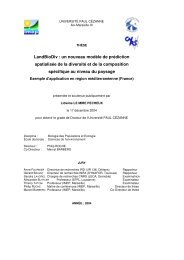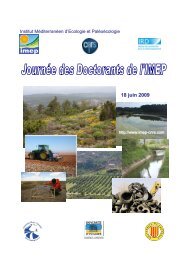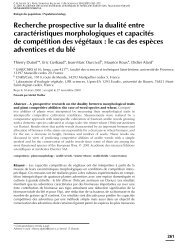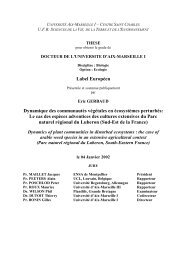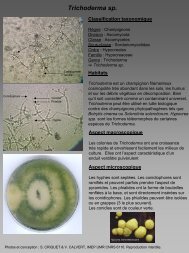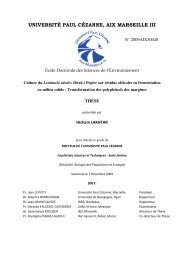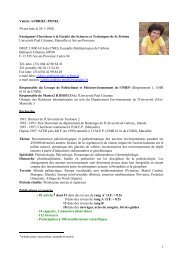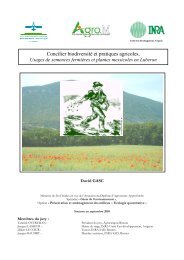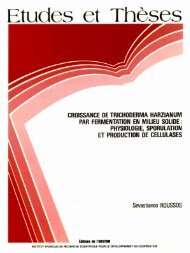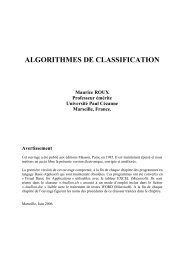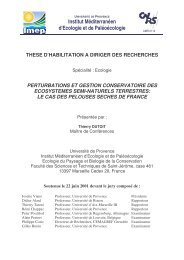Vegetation dynamics during the early to mid-Holocene ... - IMEP
Vegetation dynamics during the early to mid-Holocene ... - IMEP
Vegetation dynamics during the early to mid-Holocene ... - IMEP
You also want an ePaper? Increase the reach of your titles
YUMPU automatically turns print PDFs into web optimized ePapers that Google loves.
Veget Hist ArchaeobotTable 2 Radiocarbon ages for six samples from <strong>the</strong> core BM1, NW MaltaSamplenumberLab codeDepth(cm)14 C age(year B.P.)Calibr. age(cal. year B.P.)Cal. age range/probability ()MaterialdatedBM1/64A SacA-11663 845 4563 ± 30 5120 ± 655292 ± 285055–5186 (0.52)5264–5321 (0.43)CharcoalBM1/80 Poz-42441 1005 5410 ± 40 6236 ± 60 6176–6296 (0.89) CharcoalBM1/93 SacA-11668 1117.5 6115 ± 30 6964 ± 676897–7031 (0.72) Peat7125 ± 307095–7156 (0.21)BM1/100 SacA-11669 1215 6500 ± 30 7441 ± 307362 ± 377411–7472 (0.62)7325–7399 (0.38)CharcoalBM1/121 Poz-42439 1415 6650 ± 60 7521 ± 88 7433–7609 (1) CharcoalCalibrated dates are reported as means of <strong>the</strong> 2r-ranges with highest probability. Possible age-ranges with highest probabilities (in paren<strong>the</strong>ses) arealso reported as a separate column (2r-ranges). 14 C ages were calibrated by CALIB 6.1.1 based on IntCal09 calibration dataset (Reimer et al. 2009)Quercus ilex, Rhamnus lycioides ssp. oleoides and Tetraclinisarticulata, <strong>the</strong> latter being a presumed relict species(Haslam et al. 1977).Materials and methodsCoring, chronology, and stratigraphyFour cores (BM1–BM4) were recovered from <strong>the</strong> Burmarradfloodplain (NW Malta) using a percussion corer (Berettadrilling machine) in spring 2008 and 2010 (Fig. 1). The sitewas selected based on preliminary explora<strong>to</strong>ry drillingsconducted <strong>during</strong> an earlier project (Gambin 2005) thatrevealed <strong>the</strong> presence of a relatively thick and continuousterrestrial-marine sediment infill. After stratigraphicaldescriptions, core BM1 (14 m long) was subsampled every5–10 cm for fur<strong>the</strong>r pollen and sedimen<strong>to</strong>logical analyses.Five radiocarbon ages were obtained <strong>to</strong> construct <strong>the</strong> agedepthmodel. 14 C ages, reported in Table 2, were calibratedin Calib 6.1.1 using IntCal09 (Reimer et al. 2009). The agedepthmodel (Fig. 3) was constructed using non-Bayesianmodeling in <strong>the</strong> R-based package of CLAM (Blaauw 2010).The age-depth model shows an age-range of 8465–7763 cal.B.P. for <strong>the</strong> base of <strong>the</strong> core at 1,400 cm. However, in thisstudy, only <strong>the</strong> calibrated chronology for <strong>the</strong> interval of12–9 m has been shown (see below). This interval starts withupper estuarine dark grey silts (1,200–1,115 cm) whichsuddenly change in<strong>to</strong> a fine-grained peat formed in a closedfreshwater wetland system. At about 1,105 cm, lower estuarinegrey silts replace <strong>the</strong> wetland organic deposits andcontinue up <strong>to</strong> about 975 cm where <strong>the</strong>y grade in<strong>to</strong> <strong>the</strong> openmarine grey shelly sands.Pollen analysisA series of tests was conducted all along <strong>the</strong> core <strong>to</strong>locate <strong>the</strong> polliniferous sections of <strong>the</strong> sample. Thesection 1,200–900 cm presented good pollen preservationand was pollen-rich. We focused our attention on thissection with a sampling resolution of 10 cm. Extraction ofpollen grains and Non-Pollen Palynomorphs (NPPs) wasundertaken using 10 % HCl, 40 % HF, 37 % HCl andace<strong>to</strong>lysis (e.g. Moore et al. 1991). Pollen identificationwas performed with <strong>the</strong> help of <strong>the</strong> IMBE’s pollen referencecollection and <strong>the</strong> pollen atlases of Europe and NorthAfrica (Reille 1992, 1995, 1998). The Ostrya-type pollencurve may represent both Carpinus orientalis (Beug 2004)and Ostrya and <strong>the</strong> Quercus pollen curve is <strong>the</strong> sum ofQ. ilex-type and Q. pubescens-type. Dinoflagellates weredetermined by Laurent Londeix (EPOC, University ofBordeaux); NPPs were identified using Cugny (2011),Mudie et al. (2011) and Haas (1996). Pollen percentageswere calculated in TILIA and <strong>the</strong> pollen percentage diagram(Fig. 3) was constructed using TGView software(Grimm 2004–2005). In calculating pollen percentages ofupland plants i.e. trees, shrubs and herbaceous speciesgrowing on well-drained soils, aquatic and hygrophilousplants (Cyperaceae, spores, Typha/Sparganium-types) wereexcluded from <strong>the</strong> pollen sum. However, in calculating <strong>the</strong>pollen percentages of <strong>the</strong>se latter plants, <strong>the</strong>y were includedin <strong>the</strong> Total Pollen Sum. Hence, <strong>the</strong> final pollen diagram is asyn<strong>the</strong>tic diagram in which <strong>the</strong> pollen curves calculated withtwo above methods are placed <strong>to</strong>ge<strong>the</strong>r. The pollen diagramwas subdivided in<strong>to</strong> Local Pollen Assemblage Zones(LPAZs) by applying stratigraphically-constrained clusteranalysis <strong>to</strong> percentage data using CONISS software includedin <strong>the</strong> TILIA package (Grimm 1987, 2004–2005). Pollenconcentration values were also calculated by <strong>the</strong> addition ofLycopodium tablets (S<strong>to</strong>ckmarr 1971) <strong>to</strong> check that <strong>the</strong>pollen percentage variations were not an artifact of lowpollen concentration values. PCA analysis was applied <strong>to</strong>pollen percentages using XLSTAT v. 2009.3.02 (Addinsoft,Paris 1995–2009) and <strong>the</strong> axis 1 (18 % of variability) scoresfor different samples were plotted against <strong>the</strong> depth in <strong>the</strong>pollen diagram (Fig. 3).123



